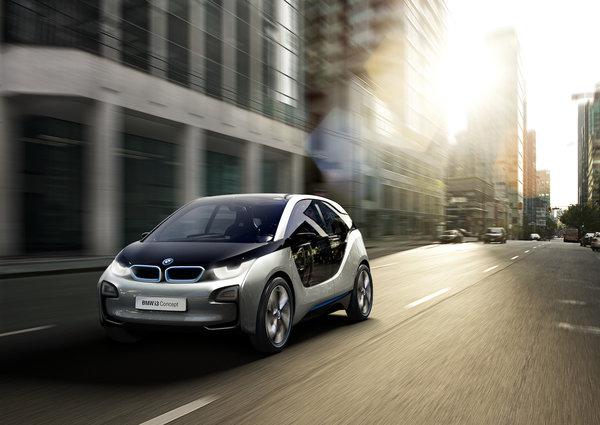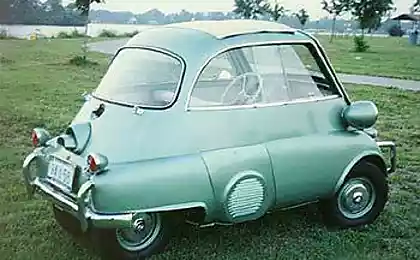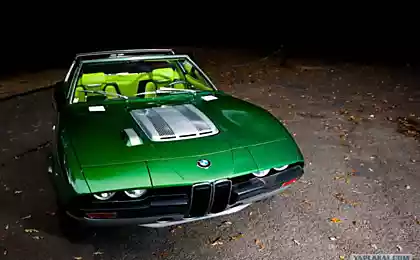420
BMW introduced models i3 and i8
Bavarians first showed prototypes of two new products of the future - electric golf class i3 and hybrid sports car i8.

Both models use a new body structure, characterized in that the machine as it is divided into two parts: an aluminum frame, which is attached to all the technical stuffing, and carbon cabin for passengers. This concept is called LifeDrive. Designers proceeded from the fact that the traditional electric cars and hybrids are heavier than petrol counterparts due to massive batteries. But the BMW i3, as a model of class, weighing just 1250 kg, which is less than the absolute majority of cars in this category. If produced now electric Nissan Leaf and Mitsubishi i-MiEV - vehicles with a calm temperament, the BMW i3 has good dynamics. Its electric motor develops 170 hp, allowing acceleration to 100 km / h in 7, 9. For comparison, the Nissan - 11, 9. The highlight of BMW battery is that the battery is "wrapped" liquid cooling and heating. This allows you to save the battery ideal temperature in both summer and winter. One charge is enough for 224 kilometers, if you go at a leisurely eco mode, and if you do not particularly care about saving energy, the power reserve will amount to 130-160 km. But as an option the machine can be equipped with a conventional engine, the thrust will not be transmitted to the wheels, and a generator, recharging the battery. Charging from the usual outlets takes six hours. On the charging station from the high-voltage cable can for an hour to get 80% of the charge. Under the hood, BMW i8 - three-cylinder turbo engine capacity of 1, 5 liters, issuing 220 hp It rotates in a pair of wheels with an electric motor. Total capacity - 350 forces. On acceleration to 100 km / h, this model is spending a total of 4, 6, and a top speed limited to 250 km / h. Sports car capable of making short trips (32 km), pure electric, but the excellent dynamics have to forget. Motor power - 132 hp The essence of hybrid sports car, of course, in fuel economy. In the combined cycle it consumes only 4, 7 l / 100 km, but if you deliberately go very smoothly, it is possible to burn only 2, 26 liters of gasoline per 100 kilometers.

3.

4.

5.

6.

7.

Source:

Both models use a new body structure, characterized in that the machine as it is divided into two parts: an aluminum frame, which is attached to all the technical stuffing, and carbon cabin for passengers. This concept is called LifeDrive. Designers proceeded from the fact that the traditional electric cars and hybrids are heavier than petrol counterparts due to massive batteries. But the BMW i3, as a model of class, weighing just 1250 kg, which is less than the absolute majority of cars in this category. If produced now electric Nissan Leaf and Mitsubishi i-MiEV - vehicles with a calm temperament, the BMW i3 has good dynamics. Its electric motor develops 170 hp, allowing acceleration to 100 km / h in 7, 9. For comparison, the Nissan - 11, 9. The highlight of BMW battery is that the battery is "wrapped" liquid cooling and heating. This allows you to save the battery ideal temperature in both summer and winter. One charge is enough for 224 kilometers, if you go at a leisurely eco mode, and if you do not particularly care about saving energy, the power reserve will amount to 130-160 km. But as an option the machine can be equipped with a conventional engine, the thrust will not be transmitted to the wheels, and a generator, recharging the battery. Charging from the usual outlets takes six hours. On the charging station from the high-voltage cable can for an hour to get 80% of the charge. Under the hood, BMW i8 - three-cylinder turbo engine capacity of 1, 5 liters, issuing 220 hp It rotates in a pair of wheels with an electric motor. Total capacity - 350 forces. On acceleration to 100 km / h, this model is spending a total of 4, 6, and a top speed limited to 250 km / h. Sports car capable of making short trips (32 km), pure electric, but the excellent dynamics have to forget. Motor power - 132 hp The essence of hybrid sports car, of course, in fuel economy. In the combined cycle it consumes only 4, 7 l / 100 km, but if you deliberately go very smoothly, it is possible to burn only 2, 26 liters of gasoline per 100 kilometers.

3.

4.

5.

6.

7.

Source:
























